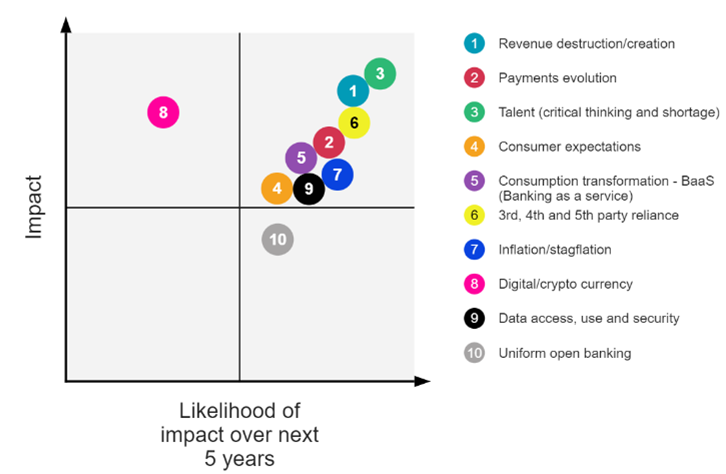4 Components of Scenario Planning
December 1, 2021
|
|
 9 minute read – Preparing for the future is critical for every business, in order to ensure it is relevant and able to manage risk and take advantage of opportunities. Of course, this would be easier to do if leaders knew what the future held, or at least had a semi-transparent crystal ball. So how do leaders prepare for the future when it’s impossible to know what the future holds?
9 minute read – Preparing for the future is critical for every business, in order to ensure it is relevant and able to manage risk and take advantage of opportunities. Of course, this would be easier to do if leaders knew what the future held, or at least had a semi-transparent crystal ball. So how do leaders prepare for the future when it’s impossible to know what the future holds?
One of the ways to prepare is through scenario planning, which can help leaders think through a range of futures. Scenario planning is not new – however, it has become more important as the pace of change accelerates, and the feeling of uncertainty has grown.
Scenarios can, and often should, be used in every part of the business planning process, from strategic planning and strategic financial planning, to leadership development and critical thinking. Given the extent of how scenarios can be used and how much can go into them, we have identified four high-level components that leaders should consider as part of their scenario planning process.
Clarity of Objectives
Be clear on the objectives and make sure there is alignment on what you are trying to accomplish with scenarios and scenario planning. This sounds straightforward and, in many ways, it is. So why call it out? In the scenario planning process, leaders are trying to balance the need for structure with the desire to create an environment of freethinking. Having clear objectives helps accomplish this. Also, this step is often missed which, again, given the balance of structure and freethinking, leads to a less productive scenario planning process.
Types of Scenarios
The number of scenarios an organization could test is endless. So how do organizations go about organizing their scenarios and deciding which ones to test?
One way to organize is to think through the environmental factors and trends that could impact the organization, as well as the potential impact of factors that are unique to your organization. These are, respectively, called systemic and idiosyncratic scenarios.
Systemic scenarios focus more on macro or environmental issues that have a broader impact on the financial services industry or economy. Examples of this are inflation and talent shortages.
Idiosyncratic scenarios are focused on unique impacts to a specific institution based on its business model, geography, and so on. Examples of this are natural disasters or a major competitor that moves into the market.
Using this approach, teams can develop a list of systemic and idiosyncratic scenarios that the organization should work through. Also, keep in mind that idiosyncratic scenarios may develop out of a systemic scenario. For example, the team may say talent shortage is a systemic scenario that every institution is dealing with. However, losing key senior team members unexpectedly is an idiosyncratic scenario that is unique to that institution. Taking that example one step further, a scenario could be the organization losing one or two members that are key to the success of their business model.
Once the team has a list of scenarios, they can then work through a process of ranking them to help prioritize where to focus. In the example below, a leadership team brainstormed primarily systemic scenarios and then scored them based on their potential impact and likelihood of impact over the next 5 years:
Ranking Scenario
Qualitative vs. Quantitative
Once the scenario(s) have been decided, teams can determine how they want to approach the scenario by asking: Is the desire to get results that are quantitative, qualitative, or both?
A qualitative approach will often focus on the potential impact to customers, team members, partners, and processes. This approach could include working through questions like:
- What events could potentially occur?
- How could it change consumer and/or team member behaviors?
- How could the events impact our business model?
- What different actions would be needed?
A quantitative approach can be financial, but doesn’t have to be. It might include more data and numbers that need to be analyzed as part of the scenario. If the scenario does have a financial component, then using different tools like ALM models, forecasting models, loan production analyzers, and credit risk analytics would be part of the work.
Some scenarios will focus more on qualitative approaches, like talent shortages, while others will be more quantitative like inflation. In reality, scenarios will have elements of both. Initially, individuals, teams, and organizations may gravitate towards one approach over the other given their preference. However, it is important to develop competencies for incorporating both quantitative and qualitative views.
A key for leaders is to decide where they want to spend their energy when it comes to the approach.
Depth
The same scenario can be addressed at different levels depending on its importance and the resources a team wants to allocate. So, it can be helpful to ask: What level and depth should we work through?
Organizations do not need to commit large amounts of time or go straight to an analysis tool to get started. They might start simple and decide later whether more depth is needed. Said differently, don’t let time and resource constraints be an obstacle to working through a scenario. For example, there may be a scenario the team wants to explore based on their prioritization but time is limited – maybe they only have 15 minutes. Even in this time, the team could get started.
The team could take a qualitative approach by doing a 180-second exercise and listing out the potential impacts and/or opportunities. Alternatively, the team could take a quantitative approach, list the impacts, and do napkin math of the potential financial outcomes to Return on Assets (ROA) and Net Worth (NW). The team could then decide if they need to dig deeper and add additional depth to the thinking on the scenario.
The level of depth can be extensive. The example below provides a concept for how leaders can think through the level of depth appropriate for the scenario:
Again, not every scenario will require Level 3 depth. The key is to think through what the organization needs in working through the scenario. Then, based on resources and time, determine the level of depth needed, which could evolve throughout the process.
Inflation Scenario
To pull this all together, we are going to walk through an example using inflation. In this example, a team has identified inflation as a systemic scenario and wants to take a quantitative approach. Given the level of importance of the scenario and the desired outcomes, the team determines they’ll need to go to a Level 2 depth.
As part of working through the scenario, the team determines there are many views of inflation with varying impacts. Some types of inflation could have a positive financial impact while others may have a negative financial impact. As a result, the team identifies 6 inflation paths that could impact their organization:
Having worked through the paths, the team starts to model out the financial impacts. Since the paths have more than one isolated variable, they use a forecasting model to run out the paths so they can connect multiple variables. They then compare the results so they can see the range of impacts:
In most cases, inflation would hurt ROA anywhere from 16 basis points to 47 basis points. However, there is a path (D) where inflation would actually help ROA. This is important for leaders to know, especially as some scenarios, such as inflation, would seem to be all about risk on the surface.
Next Steps
On the other side, this could help your organization decide against other actions or, at least, provide you with a better understanding of the pros and cons of the actions you’re taking. Look for common actions that would help the organization across most paths. This can help prioritize actions the team can take, even if there is uncertainty about which path may occur.
Similarly, the team can identify which actions are helpful in specific paths but may actually be detrimental in another path. Again, in preparing for the future, knowing the risk and the return of each action is invaluable.
Teams should follow a similar process across a wide range of scenarios. They should keep an inventory of actions and then look for commonalities where certain actions would help in many scenarios. This could elevate the urgency for taking a particular action now or in the near future.
The future is uncertain, but that doesn’t mean leaders, teams, and organizations can’t prepare. Scenario planning is a key tool for organizations to think through tomorrow today and determine actions they can take. While scenario planning can go to a great level of depth, it can also be fairly simple, straightforward, and fun. Make sure you’re involving cross-functional teams to ensure broad, diverse, and deep thinking. The key is to get started and keep practicing so it becomes an ingrained competency.











